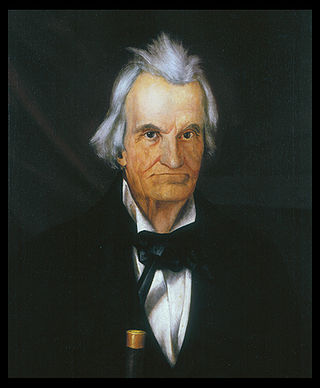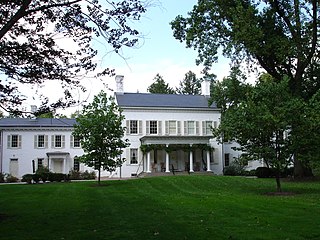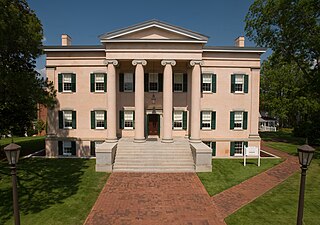
John Pope was a United States Senator from Kentucky. He was a member of the United States House of Representatives from Kentucky, Secretary of State of Kentucky, and the third Governor of Arkansas Territory.

John Middleton Clayton was an American lawyer and politician from Delaware. He was a member of the Whig Party who served in the Delaware General Assembly, and as U.S. Senator from Delaware and U.S. Secretary of State.

Grouseland, the William Henry Harrison Mansion and Museum, is a National Historic Landmark important for its Federal-style architecture and role in American history. The two-story, red brick home was built between 1802 and 1804 in Vincennes, Indiana, for William Henry Harrison (1773–1841) during his tenure from 1801 to 1812 as the first governor of the Indiana Territory. The residence was completed in 1804, and Harrison reportedly named it Grouseland due to the abundance of grouse in the area.

Andrew Stevenson was an American politician, lawyer and diplomat. He represented Richmond, Virginia in the Virginia House of Delegates and eventually became its speaker before being elected to the United States House of Representatives; its members subsequently elected him their Speaker. Stevenson also served in the Jackson administration for four years as the U.S. ambassador to the United Kingdom before retiring to his slave plantation in Albemarle County. He also served on the board of visitors of the University of Virginia and briefly as its rector before his death.

Joseph Duncan was an Illinois politician. He served as the sixth Governor of Illinois from 1834 to 1838, the only Whig to ever govern the state. Before becoming governor he served four terms in the United States House of Representatives as a Democrat.

William Lee Davidson Ewing was a politician from Illinois who served partial terms as the fifth governor of the state and as U.S. Senator.
Benjamin Edwards was an American merchant and political leader from Montgomery County, Maryland. He represented the third district of Maryland for a very short time in the United States House of Representatives in 1795 after Uriah Forrest resigned.

Thomas Metcalfe, also known as Thomas Metcalf or as "Stonehammer", was an American politician who was a U.S. Representative, Senator, and the tenth Governor of Kentucky. He was the first gubernatorial candidate in the state's history to be chosen by a nominating convention rather than a caucus. He was also the first governor of Kentucky who was not a member of the Democratic-Republican Party.

Morven, known officially as Morven Museum & Garden, is an historic 18th-century house at 55 Stockton Street in Princeton, New Jersey. It served as the governor's mansion for nearly four decades in the 20th century, and has been designated a National Historic Landmark for its association with Richard Stockton (1730-1781), a signer of the United States Declaration of Independence.

The Vandalia State House, built in 1836, is the fourth capitol building of the U.S. state of Illinois. It is also the oldest capitol building in Illinois to survive, as the first, second, and third capitol buildings have all disappeared. The brick Federal style state house has been operated by the state of Illinois as a monument of Illinois' pioneer years since 1933. It is located in Vandalia, Illinois, on the National Road, and listed on the National Register of Historic Places.

The Illinois Governor's Mansion is the official residence of the governor of Illinois. It is located in the state capital of Springfield, Illinois, near the Illinois State Capitol building, and the Lincoln Home National Historic Site. The Italianate-style Mansion was designed by Chicago architect John M. Van Osdel with a modified I-shaped configuration with a long central section stretching front to back. The 16-room manor was completed in 1855 and was first occupied by governor Joel Matteson, who held the official grand opening on January 10, 1856. It is one of the oldest historic residences in the state of Illinois and one of the three oldest continuously occupied governor's mansions in the United States. In 1898 alterations to the exterior added neoclassical elements. In 1972, the Illinois Governor's Mansion Association was founded as a charitable corporation to assist in the maintenance and programming at the mansion. The Mansion was added to the National Register of Historic Places in 1976.

The Old Louisiana Governor's Mansion is located at 502 North Blvd. between Royal and St. Charles Streets in Baton Rouge and was used as Louisiana's official gubernatorial residence between 1930 and 1963; a new residence was completed in 1963. The Old Governor's Mansion was built under the governorship of Huey Long, its first resident. The building is reported to be inspired by the White House in Washington D.C. as it was originally designed by Thomas Jefferson. It is said that Long wanted to be familiar with the White House when he became president, so he had the White House duplicated in Baton Rouge. Some dispute this legend and simply say that the building is merely a fine example of a Georgian-style mansion.

The California Governor's Mansion is the official residence of the governor of California, located in Sacramento, the capital of California. Built in 1877, the estate was purchased by the State of California in 1903 and has served as the executive residence for 14 governors. The mansion was occupied by governors between 1903–1967 and 2015–2019. Since 1967, the mansion has been managed by California State Parks as the Governor's Mansion State Historic Park.

Georgia's Old Governor's Mansion is a historic house museum located on the campus of Georgia College & State University (GCSU) at 120 South Clarke Street in Milledgeville, Georgia. Built in 1839, it is one of the finest examples of Greek Revival architecture in the American South, and was designated a National Historic Landmark for its architecture in 1973. It served as Georgia's executive mansion from 1839- 1868, and has from 1889 been a university property, serving for a time as its official president's residence. It is an accredited museum of the American Alliance of Museums and in 2015 was named an affiliate of the Smithsonian Institution.

The Andrew J. O'Conor III House, also referred to as "Riverbend" and "Buena Vista," is a historic home in the city of Ottawa, Illinois, United States. The structure that exists today was originally constructed in 1848 and underwent major remodeling in 1922. The house was added to the U.S. National Register of Historic Places in 1993.

The 1834 Illinois gubernatorial election was the fifth quadrennial election for this office. U.S. Representative Joseph Duncan was elected by a majority of the voters. He defeated former Lt. Governor William Kinney and former state treasurer Robert K. McLaughlin.
Alexander M. Jenkins was an American politician. Between 1834 and 1836 he served as Lieutenant Governor of Illinois.
Charles Blaney Cluskey was an Irish architect active from the 1830s to the start of the Civil War, and therefore he is recognized as an antebellum architect. He is reputed to be the initiator of the Greek Revival–style in the south, and his commissions, both public and private, can still be seen in Augusta, Milledgeville and Savannah, Georgia.

William Reddick was an Irish-American businessman, farmer, lawman, politician, landowner and philanthropist. Immigrating to the United States with his family at the age of four, Reddick became one of the most prominent citizens of early Ottawa, Illinois. Having a lifelong interest in education, Reddick supported the foundation of the University of Illinois and assisted in the establishment of a public school system for the youth of Ottawa.
William Beatty Archer was an Illinois politician and businessman. Archer was a member of the Illinois General Assembly from 1825 until 1843, during which time he also served on the state Board of Canal Commissioners and unsuccessfully ran for higher office twice. He also founded the city of Marshall, Illinois, was a captain in the Black Hawk War, and supported Abraham Lincoln's vice presidential nomination at the first Republican National Convention in 1856.


















